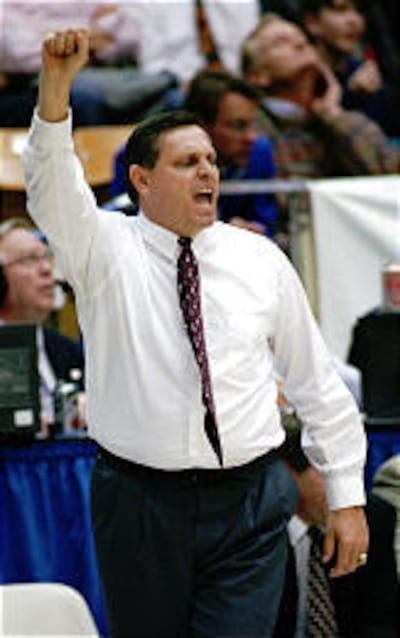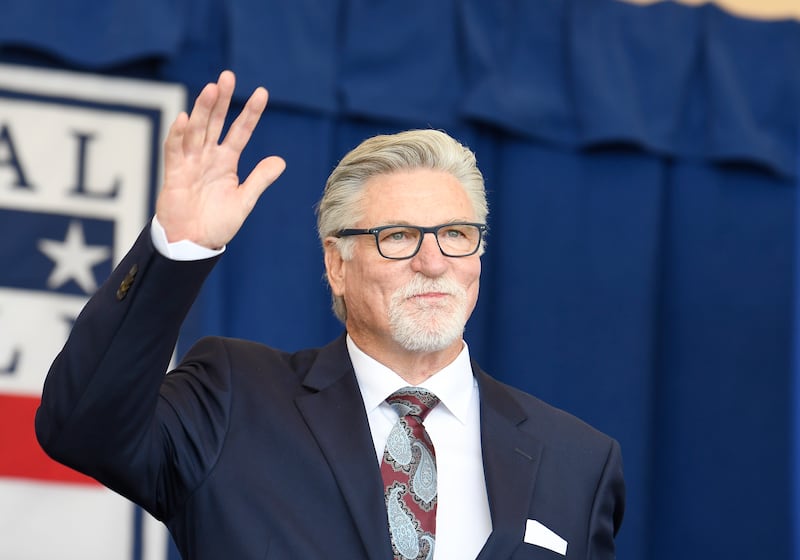Former BYU pitcher Jack Morris hasn’t returned to Provo very often since he became a Major League superstar, but there he was, a tall, distinguished, towering man, his Tom Selleck signature mustache white as snow. He wore glasses and no cap atop his white-haired head.
It was part of a remarkable scene at a top-heavy 50th BYU Athletic Hall of Fame induction ceremony Friday night at the basketball Annex where seven, including Morris, were enshrined.
The group will then be recognized at halftime of BYU’s game against TCU Saturday at LaVell Edwards Stadium.
Morris, who threw 10 shutout innings to win Game 7 of the 1991 World Series, boldly proclaimed at the podium, “I can’t be more proud to say to the world, I played at BYU.”
Sitting nearby was another inductee, Roger Reid, a former junior college All-American at Eastern Utah and a man who’d enjoyed his own Morris worship back in the day.
Sitting in a wheelchair, decked out in a shiny tuxedo, Reid was the final inductee of the night, honored for 20 loyal years coaching Cougar basketball, eight of them as one of the program’s winningest coaches.
Reid hopes he can return home at the end of November for the first time in nine months following a life-threatening accident last spring. It was quite a roll up to the podium in his wheelchair, assisted by his youngest son, Darren, in this the most challenging year of his life.
Reid suffered multiple broken bones in a golf cart accident back in April at a Nephi golf course. His wife Diane, who was suffering from Alzheimer’s for years, drove the cart into Reid, pinning him under the cart face down in a sand trap. She never realized what had transpired.
Since then, Reid, his wife’s sole caretaker, has undergone multiple surgeries, including a shoulder replacement this fall. Diane Reid passed away in August.
“It’s a tremendous honor,” said Reid of his induction. “But this is an award that represents a lot of players who deserve it for what they did, how hard they worked and what they accomplished.”
Reid, who is wheeling himself around an American Fork rehabilitation center now that his left broken leg has healed, is one of the most successful and respected coaches in BYU men’s basketball history.
He compiled a record of 152-77 as the third-winningest coach in program history and was two-time WAC Coach of the Year, leading BYU to five NCAA Tournament appearances, three regular-season championships and two WAC Tournament titles.
Friday’s honor was a big deal for Reid. It is also long overdue since his abrupt dismissal in 1996, a painful experience for both him and BYU. It is well-deserved, about time, and it comes at a moment that is very meaningful to him and his family. Good on BYU.

Morris and Reid join a loaded 50th Anniversary Hall of Fame induction class in 2025 that also includes the following:
* Tyler Haws, the most prolific scorer in BYU basketball history, who surpassed Naismith Award winner Jimmer Fredette’s scoring record of 2,599 points in 2015 with 2,720 points.
*Three-time volleyball All-American Alexa Gray, who was also a two-time WCC Player of the Year (2012-2015), and led BYU volleyball to its first appearance in an NCAA championship match.
* Women’s track star Nachelle Stewart Mackie, one of the most decorated middle-stance runners in program history and the only BYU athlete to be the 800-meter national champion outdoors and indoors in the same year.
* Trevor Matich, a center and leader on the 1984 football national championship team who was a first-round NFL draft pick and is now a 17-time Emmy Award-winning ESPN commentator.
* Morris, one of the most competitive athletes as a pitcher for Glen Tuckett who went on to be a four-time World Series champion with the Detroit Tigers, Minnesota Twins and Toronto Blue Jays.
*Mark Philbrick, a nationally award-winning university photographer, whose chronicling of BYU sports teams spans four decades.
This induction class includes a new category, the Legends. Morris, who first came to BYU from Minnesota with his brother Tom in 1974, fits this new category.
For the first time, the Hall of Fame committee created this class to allow athletes whose eligibility expired 40 years ago and may not have met all the strict requirements used in the past.
“This allows the committee to consider a deserving athlete from the past and exempt them from one or two aspects of qualification,” said committee member Duff Tittle, senior athletic administrator.
“This category in no way diminishes them as a member of the Hall of Fame, it just makes their induction possible through this category.”
A few of the requirements in past years include All-America and All-Conference citations or national recognition, championships and titles and obtaining a degree through graduation.
The Philbrick induction is an interesting honor because he has been in the background, a silent and hidden personality behind the scenes. His work with a camera was not only artistry and historic, but quite remarkable.
Bridging a remarkable transition from celluloid film and darkroom work to the digital age, Philbrick not only was on the scene shooting pictures of the most dramatic moments in BYU sports history, but when he got back to the office, he was tasked with creating a filing system to retrieve all that work.
This required a massive amount of cataloging and transferring all those film frames to digital storage. Every newspaper, TV station, and broadcast outlet looking to do historic coverage of BYU sports has likely made a call to Philbrick to find them a shot.
In the three books I’ve written, requiring extensive photos to make them complete, Philbrick’s attention to detail and ability to find individual shots and big moments stood out as quite remarkable.
The Morris legend launched mostly after he left Provo. He became a machine on the mound and made headlines for decades with his performances as a five-time All-Star with different teams.
Haws had a career that established a masterclass in midrange jump shooting. He was a tireless, hardworking machine who became automatic as a shooter, an artist at using screens and picks to get off his shot, despite being double- and triple-teamed.

At a school known for its distance runners, Mackie was a bonafide burner. A gutty finisher with a tremendous threshold for maintaining speed for half a mile, she remains one of the most gifted 800-meter competitors the school has ever seen.
Gray, a native of Canada, remains an active professional volleyball player today, most recently joining LOVB in Salt Salt Lake City as an elite outside hitter.
Matich, whose knowledge and verbal acumen is a regular feature on ESPN’s weekend wrapups and SportsCenter, once learned not only his own assignments as the center on BYU’s 1984 championship team, but he knew the individual play assignments of right and left guards and right and left tackle positions and could play each if called upon.
Matich told the audience assembled Friday that back in the days of Roger French, BYU’s offensive line succeeded because it could do half a dozen things you don’t see done in college or the NFL today, including successfully playing man-on-man blocking schemes with unique reads.
BYU athletic director Brian Santiago and the selection committee hit it out of the park with this unique and distinguished Hall of Fame class. The depth of candidates, the history involved and the recognition given was not only well-deserved but very timely, especially for Reid and Morris.
Only 1% of BYU athletes have been inducted since the ceremonies began in 1975.


